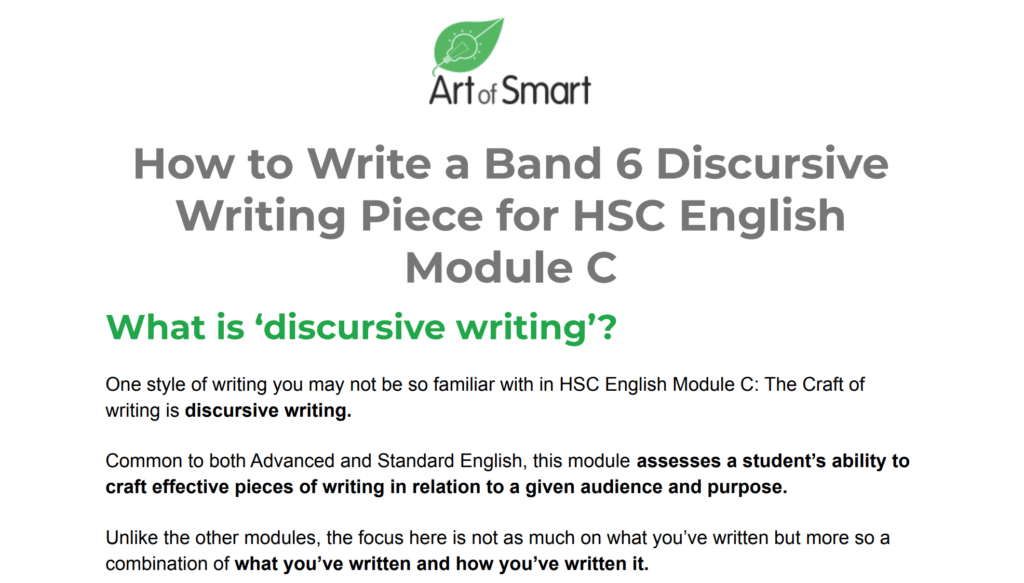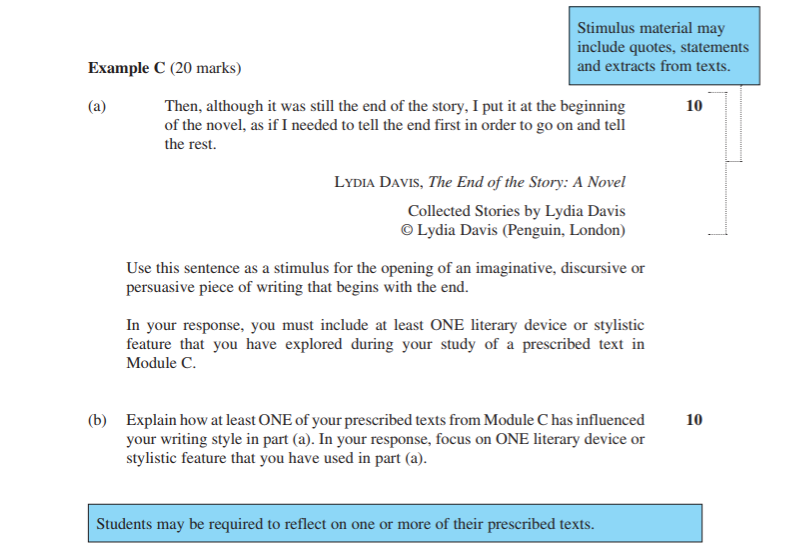Just heard about the term discursive writing from HSC English for Module C?
Whether you’re an expert or beginner at discursive writing, we’re here to help secure a Band 6 for Module C! We’ll break down exactly what discursive writing involves and how to produce a Band 6 discursive writing piece.
Keen to know more? Then keep scrolling!
What is Discursive Writing?
What’s in a HSC Discursive Writing Question?
How to Write a Discursive Text
How to Structure Your Discursive Writing
Tips for Discursive Writing Features
Should You Memorise Your Discursive Writing Piece for Module C?
Discursive Writing Examples
Discursive Writing Example Prompt
What is Discursive Writing?
Discursive Writing Definition
NESA defines discursive writing as including:
Texts whose primary focus is to explore an idea or variety of topics. These texts involve the discussion of an idea(s) or opinion(s) without the direct intention of persuading the reader, listener or viewer to adopt any single point of view. Discursive texts can be humorous or serious in tone and can have a formal or informal register.
In this article, we’ll be giving you the lowdown on all types of discursive writing.
This encompasses forms such as creative non-fiction, travel blogs, discussion essays, speeches, personal essays and much more!
Discursive Writing for HSC
The purpose behind discursive writing is for you to engage in a deeply relatable, thought-provoking discussion by exploring multiple perspectives on a topic. It is not argumentative nor is it imaginative.
One style of writing you may not be so familiar with in HSC English Module C: The Craft of writing is discursive writing.
Common to both Advanced and Standard English, this module assesses a student’s ability to craft effective pieces of writing in relation to a given audience and purpose.
Unlike the other modules, the focus here is not as much on what you’ve written but more so a combination of what you’ve written and how you’ve written it.
The module takes up approximately 20 hours of course time. It will be assessed in one section in English Paper 2 in the HSC external examination block held in October, through one question containing up to two parts.
Discursive Writing is a new text type to appear on the syllabus in Module C. Let’s take a quick look at a part of the rubric for this module:
Excerpt of Module C in HSC English Syllabus from NESA
Modes of Writing
From this, we can see that within this module, you will be required to write in four different text types:
Imaginative: This type of writing often takes the form of a narrative and requires you to combine plot, setting and character to craft a short story.
Discursive: We’ll be diving into what exactly this style of writing entails in this guide!
Persuasive: This writing style aims for you to convince the reader of a particular argument or idea. It can be written in the form of an academic essay, personal essay or speech.
Informative: When writing an informative piece, you’ll be informing the reader of a particular topic — these are most commonly written as reports, explanations or descriptions.
For more on the different text types explored in Module C, check out our article!
What’s in a HSC Discursive Writing Question?
Here’s an example from NESA’s HSC English 2019 sample paper of a discursive writing question:
As you can see, Section III of the HSC exam paper focusses upon Module C: The Craft of Writing.
The question may ask you to write a persuasive, discursive or imaginative writing piece about a significant idea you have explored in your prescribed text whilst also using a stimulus.
Let’s take a look at another discursive writing question:
The exam question for this section may also be split into part (a) and part (b) — but don’t freak out!
Part (a) will require you to write an imaginative, discursive or persuasive writing piece using the stimulus provided, as well as one technique or stylistic feature used in your prescribed text.
Part (b) involves a reflective statement which will require you to explain how your prescribed text influenced your imaginative, discursive or persuasive writing piece in part (a).
In part (b) you may also be required to explain the literary or stylistic devices you employed in your writing.
Differences Between A Regular Persuasive Essay and Discursive Writing
Scratching your head at what you should do differently for your discursive writing, check out the key differences below!
| Discursive | Persuasive | |
|---|---|---|
| Purpose | To engage in a thought-provoking discussion by exploring multiple perspectives on a topic. | To argue a single perspective. |
| Structure | Includes an introduction, body and a conclusion. Varied number of paragraphs and paragraph length – you have a bit of freedom here. | Includes an introduction, body and a conclusion. Usually 3-4 body paragraphs, sometimes more. Body paragraphs typically follow a strict PEEL structure and paragraphs are of similar length. |
| Style | Try to strike a balance between formal and informal. You’re writing for an educated audience, yes, but you want your tone to also reflect who you are as a person – so hopefully something a little more friendly and open. | Formal, academic language. Don't write how you would talk. |
| Use of First Person | Go for it. | Generally avoided unless the question lends itself well to first person (e.g. something asking you to reflect). |
| Use of Evidence | Include it, but you don’t need to conduct the literary analysis you would do in an essay. | Included throughout body paragraphs and analysed following a particular structure (PEEL). |
| Figurative Language | Welcomed. | Only include it if it’s part of a quote you’re analysing. |
Pros and Cons of Discursive Writing
To get some extra knowledge on the form, here is a good list of the pros and cons for discursive writing!
| Pros | Cons |
|---|---|
| - Has the capacity to be incredibly personal; you can write and explore your own genuine thoughts, opinions and life experiences rather than those that simply look good in an essay. - The intended writing style is one that reflects your own personal voice - not as an author of a story or as an essayist, but your voice as a person. This means that you have the freedom to write both formally and informally, figuratively and factually. It’s up to you! - You can leave it open-ended. | - The amount of freedom you have in this text type can be intimidating. It’s hard to know whether or not you’re doing it right! - This text type is relatively new in the syllabus so you may not have had as much practice in writing it as you would have had with the other types. - I anticipate that, like imaginative writing, this one will also be marked rather subjectively. |
At Art of Smart Education our expert English Tutors can support you with Discursive Writing with tailored tutoring in your home or online.
How to Write a Discursive Text
While there is no single formula or “quick fix” to get a Band 6, there are certain steps you can take to increase your chances!
That said, you won’t jump from a Band 2 to a Band 6 overnight so be prepared to invest time and effort to achieve a Band 6-level result, or as close to it as you can get.
Discursive writing can be tricky. Our tutors here at Art of Smart can help you boost your marks with expert tips and tricks! Check out the K-12 English support we can provide in Parramatta, and all across Sydney!
Use the Discursive Writing Syllabus to Your Advantage
Let’s start by revisiting the marking criteria for Module C: The Craft of Writing:
- Craft language to address the demands of the question.
- Use language appropriate to audience, purpose and context to deliberately shape meaning.
So, how might these criteria apply to a discursive piece of writing?
| Criterion | How can I address this? |
|---|---|
| Craft language to address the demands of the question | This requires you to use language in a way that addresses what the question is asking you to do, so a good place to start is by breaking down the question itself. Ensure you have read the question carefully. Read it at least three times, underlining all key words. Only move on from reading over the question once you are 100% sure you understand it inside out. |
| Use language appropriate to audience, purpose and context to deliberately shape meaning | In a discursive piece of writing, you’ll be expected to write using your own personal voice – not your voice as the author of a story, or your voice as an essayist – your voice as a person. This is what your reader will be expecting and thus, this is what you should aim for to achieve. Momentarily forget everything you know about regular essay writing and let your own voice flow through onto the page, in a way that is authentically you. |
How to Start Your Discursive Piece
This will ultimately depend on the question so ensure you read it carefully.
Likely, you will be asked to explore a key idea or concern from one of your prescribed texts — either from Module C or another module.
You may take this literally, exploring the idea as it is presented in the prescribed text or instead, you can think laterally and consider how this idea applies to the real world, occasionally bringing in the text — or a related text — as examples.
Note that many of the key ideas and concerns encountered in your prescribed texts are quite broad and malleable, so you can twist them in any way you want.
Tip: Manipulate the Question
As the focus here is on unleashing your own personal voice as a writer, it helps to be writing about something you a) are genuinely interested in and b) know a bit about. Manipulate the question as is necessary.
Example
You might decide to write about power — as it is a key concern in the prescribed text for the Common Module,Nineteen Eighty Four (Orwell).
Power lends itself quite easily to politics but what if you don’t want to talk about politics? Instead, you might write about the psychological power of manipulation or the importance of individual empowerment.
As the marking criteria for Module C explicitly ask for language crafted to “address the demands of the question”, it is imperative that whatever you do end up writing about is something that can be related to the question — by both yourself and your marker.
Discursive Writing Examples
Here are some of our favourite pieces of discursive writing!
- Immigrating to English by Ocean Vuong
- Slouching Towards Bethelehem by Joan Didion
- Just Kids by Patti Smith
- Upstream by Mary Oliver
You can also trawl through newspapers, magazines and blogs for great examples of discursive writing:
Tip: Also check out TED talks, many of which take on a discursive style and all of which are available to view online for free.
Most talks uploaded on TED’s official site also have a transcript so you can not only follow along, but also take note of how the speaker uses language to create meaning.
Check out the 20 Most-Watched TED Talks!
How to Structure Your Discursive Writing
While discursive writing is not wedded to a formal structure, it helps to plan things out before you start writing. This can help to avoid confusion or a lack of clarity in your writing.
You’ll want to follow a logical, sequential structure:
Introduction – Catch your reader’s attention and introduce them to your topic – whether explicitly or implicitly.
Body – Several paragraphs in which you explore your topic in greater detail. These can be of varying lengths and the number of paragraphs is up to you.
Conclusion – Sum up your discussion and end on a reflective, thought-provoking note.
Planning your response beforehand — even if it’s some dot points crammed into the corner of the page — allows you to think deeply about how to best organise and present your ideas. For each paragraph, plan what its focus will be and which pieces of evidence you will include.
What Can You Include As Evidence in Discursive Writing?
Evidence is crucial in a discursive response as it adds legitimacy to your discussion and helps to build authenticity.
You may include, but are not limited to, the following types of evidence:
- Textual examples from prescribed texts
- Textual examples from related texts
- Personal anecdotes
- Historical events (careful not to write a history essay though!)
- References to popular culture
Do I Have to Analyse the Textual Evidence?
You can but you are not required to. This entirely depends on the nature of the question and how you prefer to answer it.
If you want your response to be focussed on texts, then some analysis may be helpful.
If you’re focussing on broader ideas or phenomena however, perhaps ease up on the techniques for now.
Tips for Discursive Writing Features
You might be thinking: Module C seems all a bit… unstructured?
Ironically, if you think that, you’re on the right train of thought! You’ve actually understood the form excellently. It’s natural to find discursive writing a little unfamiliar, considering you’re much more used to writing in a highly-structured essay style.
Discursive writing is deliberately exploratory and personal in nature. Great discursive writer Annie Dillard sums up the form well, noting that discursive writing has “a structure that arises from the materials and best contains them”.
The discursive writing style is highly personal and effectively you can dictate your own structure.
However, don’t let this freak you out! You can in fact use the vagueness of this form to your advantage.
Tip #1: Make your Personal Voice Engaging
Authors use literary techniques for a reason. They provide an interesting, more meaningful way of getting ideas across than just stating things outright.
Consider this example from our old mate, William Shakespeare:
“I will speak daggers to her but use none” (Hamlet, Hamlet, Act 3 Scene 2)
Cool, right? Shakespeare uses a great metaphor of daggers to convey the sharp hostility Hamlet plans to convey in speaking to his mother. Can’t get enough of it.
Let’s consider the same line without any techniques:
I’ll speak rudely to her but I won’t actually do anything to physically harm her.
Look, it gets the meaning across and it’s nice and direct but let’s be real — it’s boring. The daggers metaphor captures our imagination and gets us thinking whereas the rewritten, metaphor-less line simply tells us what Hamlet is planning to do, no more.
Slightly random Hamlet analysis aside, techniques such as metaphors will help bring your writing voice to life — and will sure as heck engage your reader, if used correctly.
Tip #2: Use Good Techniques in Discursive Writing
When reading your prescribed texts, take note of techniques you personally find meaningful. Not just the techniques your teacher tells you to find meaningful but ones that you actually like yourself.
Experiment with these techniques in your own writing. Loved the dagger metaphor we learnt about from Hamlet just now? Have a go at writing your own metaphor to describe the way someone speaks to another. And so on, and so forth.
Don’t just focus on your prescribed texts either. If you’re keen on a Band 6 for HSC English, you should already be engaging in regular wide reading. As you do this, take note of any cool techniques you happen upon, and have a go at creating your own.
Here’s the absolute minimum set of techniques you should be including your discursive writing:
- Varying sentence structure: write like you’re a human, not a robot!
- Tone: depending on the formality or informality of the piece, the ultimate aim is to get them so immersed that they don’t feel like they’re reading at all!
- Nuance: Add in some information that goes against your argument, then disprove it — this actually makes the reader trust your opinion!
Here are some fancier techniques you can include to secure that Band 6:
- A running symbol: especially in more creative pieces, this reminds the reader of your point of view. The symbol should evolve as your point of view evolves
- Hero’s Journey: to get your reader rooting for your side, implement the hero’s journey. Write your piece as if you’re telling a story: add a call to adventure, challenges and a transformation in your discursive writing!
- Imagery: Want your reader to feel like they’re not reading? Get them imagining the physical surroundings of your discursive text!
You’ll likely already be doing something similar to this in your classwork for Module C.
If you don’t know your techniques well, check out our handy dandy glossary!
Tip #3: Writing in First Person is Recommended
You can write in first or third person for discursive writing however first person is recommended as it allows you to craft a much more authentic and engaging personal voice.
Think of discursive writing almost as an extended, slightly-more-structured stream of consciousness. You’re exploring and bouncing between your thoughts on a particular topic, and doing so through a voice that is inherently and unashamedly yours.
While third person is not necessarily wrong, it runs the risk of your discursive writing reading more like a persuasive essay.
Tip #4: Get Personalised Feedback on Your Work
Even if you’re following the best advice on how to write a piece of discursive writing, it’s likely that you’ll struggle to accurately reflect on the quality of your work. You’ve probably heard this before: “HSC English is super subjective.” To a certain extent, this is true!
That’s why we recommend getting personalised guidance from an HSC English tutor who knows the syllabus inside and out. They can point you in the right direction and decipher your teacher’s feedback with you! That way, you’ll be able to move forward knowing that you’re doing the right things.
Should You Memorise Your Discursive Writing Piece for Module C?
In previous HSC exams, it was common practice for students to write and perfect a creative writing story, memorise that story word for word, and use it in the exam — adapting when necessary — in the hopes of a Band 6.
It seems to be heading this way with the imaginative writing component of Craft of Writing, with many students already writing and revising a story to be kept as their “safety net”.
While this can have benefits for imaginative writing, it might not play out so well for discursive writing.
The fluidity of discursive writing means that your structure and content are likely to depend almost entirely on what’s asked in the question. As you can’t predict the question, logically it is also difficult to pre-prepare a response.
Rather than rote-learning a discursive piece, it is much wiser to instead practise a range of different Module C questions using a discursive form. Have your teacher — or a tutor — read over your discursive writings and either rewrite them using their feedback, or write new responses, keeping the feedback in mind (or you can also do both).
After all, you might not even be asked to write discursively in the exam! All that time spent memorising for nothing… (same goes for imaginative writing, just sayin’…)
If you’ve already been on the lookout for practice questions, you can find a bunch in this article!
Discursive Writing Example Prompt
Now that you’re a little more familiar with discursive writing, here’s a practice question:
“I pay no attention to anybody’s praise or blame. I simply follow my own feelings” — Wolfgang Amadeus Mozart
Use this quote as a stimulus for a piece of discursive writing that expresses your perspective about a significant concern or idea that you have engaged with in ONE of your prescribed texts from Module C.
Have a go at this question and get feedback from your HSC English teacher and/or tutor.
And in the meantime — you can have a look at our monster list of Module C practice questions so you can practise your discursive writing!
Looking for some extra help with discursive writing in Module C for HSC English?
We have an incredible team of HSC English tutors and mentors who are current HSC syllabus experts!
We can help you master discursive writing and ace your upcoming HSC English assessments with personalised lessons conducted one-on-one in your home, online or at one of our state of the art campuses in Hornsby or the Hills!
Feel confident tackling Module C with personalised tutoring support in Mosman or HSC English support in Hurstville!
We’ve supported over 8,000 students over the last 11 years, and on average our students score mark improvements of over 20%!
Looking for extra HSC English support in Wollongong? Get in touch with our team to secure your Wollongong English tutor today!
To find out more and get started with an inspirational HSC English tutor and mentor, get in touch today or give us a ring on 1300 267 888!










